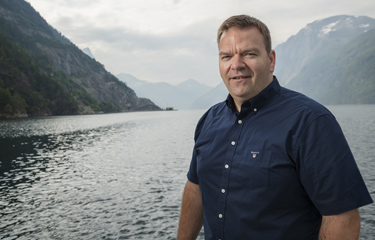Hofseth International and Hofseth BioCare founder Roger Hofseth has his sights set on developing Norway's largest fish farm.
The seafood business entrepreneur started Hofseth International as a salmon processor in 2005 and soon became a major supplier to the U.S., before stepping into salmon farming. Sixteen years later, following a series of mergers and acquisitions, the Hofseth Group has become a major global player in the salmon-farming and -processing sector, and the largest exporter of Norwegian salmon to the U.S.
Now, Hofseth has purchased an abandoned olivine mine at Sunnylvsfjorden, close to the Geirangerfjord World Heritage Site, with the intent of building a flowthrough farm that will produce 100,000 metric tons (MT) of salmon per year. The new venture, named World Heritage Salmon, is strategically placed near Hofseth’s processing facilities. However, due to the unique location of the proposed farm, it is subject to a complex application process involving special environmental and emissions permits.
Hofseth told SeafoodSource the idea of putting a fish farm in a mountain to solve some of the most vexing environmental issues plaguing traditional salmon-farming operations was not new, having been proposed at a much smaller scale by another company several years ago. But those plans never came to fruition, which would mean World Heritage Salmon would be the first successful venture to farm salmon at a commercial scale inside an abandoned mine.
“Creating a fish farm in this location will enable us to take advantage of the uniqueness of the area, in terms of a year-round stable temperature of around 10 degrees Celsius at a depth of 40 to 50 metres, which is an optimal temperature to grow salmon. This, combined with a constant similar temperature within the mountain hall, will give us excellent conditions to produce high-quality fish,” he said.
Hofseth has already signed several partnership agreements that will see the project advance quickly if and when it is approved by the Norwegian government. One of those partnerships is with Artec Aqua, a turnkey supplier of onshore aquaculture solutions, which Hofseth charged with building “the world’s greenest aquaculture facility,” he said.
“I have worked with Artec Aqua since 2017 and am happy with their design and build capabilities, so have confidence in their ability to deliver a finished package to my specification. Once we receive the green light, which I hope will be sometime this year, it will be exciting to see the build progress,” Hofseth said.
Hofseth Group’s mission is to produce sustainable, high-quality seafood that is affordable for everyone, but at the core of all the businesses is a focus on creating local value, using every last scrap of fish, and reducing environmental impact, Hofseth said. Key to achieving his green aim with World Heritage Salmon is the implementation of unique biotechnology developed by Norwegian fermentation company Hyperthermics, which will convert the farm’s annual anticipated output of 120,000 metric tons (MT) of sludge, into energy, and saleable proteins. Hyperthermics’ biotechnology relies on mass production of archaea, which are single-celled organisms, to enrich the sludge with protein, in a pre-treatment plant. Green bio-hydrogen and green biogas is then generated from the sludge, and used to provide on-site energy for the fish farm.
Hofseth said he had chosen Hyperthermics because their system works well with salt-water sludge, whereas many biogas systems only function with fresh-water waste.
“The result is a solution that will contribute to lower production costs for World Heritage Salmon, and greener utilization of potent, fresh fish sludge, and residual raw materials,” Hyperthermics CEO Erlend Haugsbø said.
Hofseth Biocare, another Hofseth Group company, will also play a key role in the project. It will use salmon offcuts from the project to produce ProGo, a salmon protein hydrolysate for use in sports and medical nutrition. By utilizing waste products created through the processing and production of salmon finished products, the company ensures that full use is made of the whole fish, thereby creating a circular economy within the group, Hofseth said.
Hofseth said his extensive experience in the industry has given him insight into navigating the vagaries of production, processing, and marketing, so creating what would be the world’s sixth-largest salmon company does not faze him. Rather, he said he is keen to see his vision become reality, and to start work on giving the old mine a unique new purpose.
“People think that building a fish farm in a mountain is expensive, but it is actually cheaper than putting up a building and maintaining it. The rock here is very hard, but Norwegian engineers have considerable experience of tunnelling through rock, so this will not present a problem,” he said. “Who knows? This may be the start of a whole new future for salmon farming.”
Photo courtesy of Tony Hall/Hofseth Group







